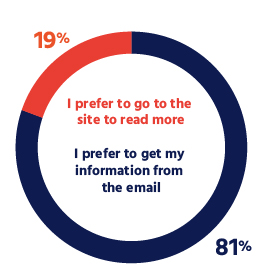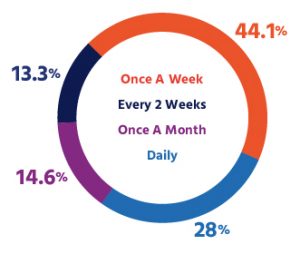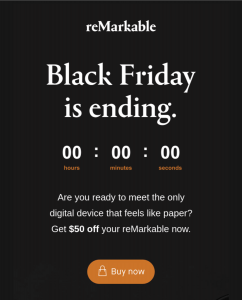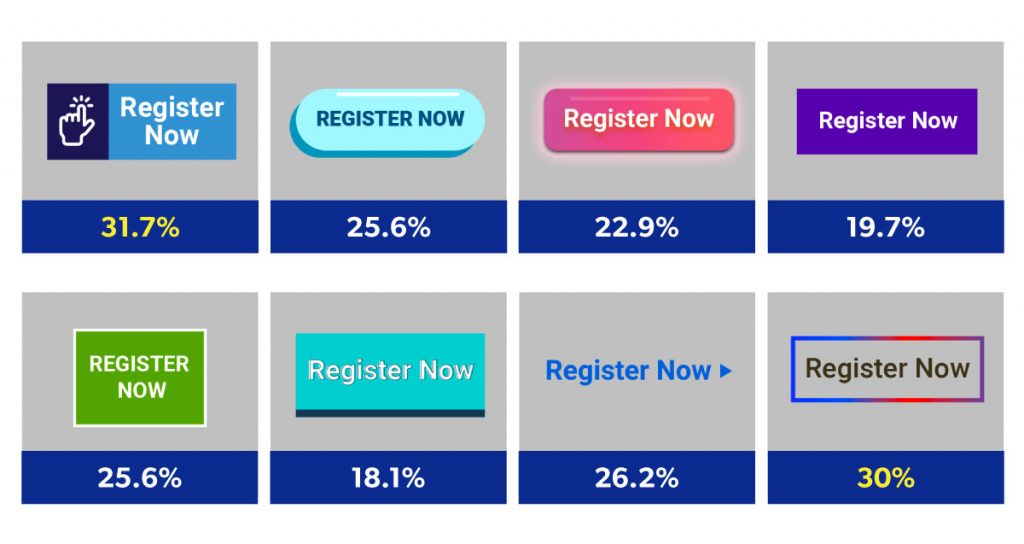Email marketing is one of the most effective ways to increase customer loyalty and retention, and it drives 40% more conversions than social advertising. Of course, that all hinges on your execution. If you’re not delivering what your customers want, you won’t get as much as you could from your email marketing efforts.
But what do customers want? We set out to learn just that.
To learn more about consumer email marketing preferences, including the interactive features they like to see, what makes them stop reading and how often they like to receive emails from a single brand, we surveyed 700 adults in the U.S. Read on to see what they had to say about email marketing to better inform your own campaigns.
Stop Signs
Your email lands in someone’s inbox, they open it and start reading. While we hope they’ll read to the very end, there’s a chance they’ll drop off. Quite a few things might make someone stop reading, but here’s what our respondents said makes them call it quits in the middle of an email (respondents were asked to select all that apply):
- 54.7% said the content is too long
- 47.5% said the content is not relevant to them
- 44.5% said the headline causes them to stop reading
- 39.1% said the subject line was misleading
- 36.6% said the design
- 18.7% said they typically read emails all the way through
Key takeaway: To keep people reading, make sure your emails are short and sweet with content that is as relevant to your audience as possible.
More Information, Please
Delivering information to your readers’ inboxes is the entire reason you send marketing emails in the first place. But are you giving them the information they need in the email, or are you asking them to visit your site to “Read More”? When we asked if respondents prefer getting their information from the email or if they want to go to the site to learn more, here’s what they said:

Key takeaway: Don’t rely on users clicking through. Put the bulk of the information you want recipients to read in the email. This may sound counterintuitive to our advice of keeping emails short and sweet, but it will allow you to explore ways to provide all the necessary information while still being succinct.
Caution: High Frequency
Marketers know that sending too many emails will cause people to unsubscribe. In fact, in part one of our email marketing survey, over 77% of respondents said that’s why they hit the “unsubscribe” button.
So how often should you send emails? Here’s what people said when we asked how often they want to receive marketing emails from a single brand:

Key takeaway: Customers are comfortable hearing from your brand weekly or even daily! But before you rework your email marketing calendar to send more frequent emails, think about whether you can deliver relevant, quality content that often. If not, sending less frequently is perfectly fine—and in most cases, preferable to more frequent, low-quality emails.
Make it Fun
It’s no secret that interactive features can keep people engaged and on a website longer than text alone. While interactivity is a little more limited in email, it’s not impossible to incorporate it. Here are the interactive email features that appeal to survey takers the most (respondents were asked to select all that apply):
- 46.7% like to see new product preview
- 43% enjoy leaving a product/service review
- 42.7% like taking polls
- 39.6% like seeing countdowns in emails
Key takeaway: Any interactive element is likely to be a hit, so experiment with different ones to find which one resonates with your audience the most. For example, a countdown is a great way to create a sense of urgency around a sale ending.

Step by Step
When making a large purchase like an appliance, furniture or car, the process isn’t always quick. With manufacturing time, shipping delays and order backlogs, it may be weeks or months before your customer gets what they ordered. When faced with a long buying cycle, we were curious to know if customers wanted an email at each step of the process. The answer? A resounding “yes.”
- 90.1% said yes
- 9.9% said no
Key takeaway: If customers are making a big purchase, they want to be kept in the loop. Look at your purchase journey and identify key points where an email would be useful for a customer. Even if it’s just a status update, identifying messaging opportunities during the sales process will only strengthen brand affinity.
Picture This
Every marketer knows that an email’s design is important. But when it comes to the assets used in the email, do readers prefer still images or videos? Here’s what they said:
- 57.8% prefer images
- 36.5% prefer videos
- 5.7% have no preference
Key takeaway: Don’t force videos in your marketing emails. If you only have images, that’s fine! Images can work on their own, or they can be combined to make a gif for an easy way to add motion to an email.
Click Here
Button design is a big part of UX, and we were curious to see which buttons people would be most likely to click. Users chose one button from two different sets. Here’s what they chose:

Key takeaway: Cool colors like blue, green and teal were chosen more consistently than warmer colors. Four of the five button designs that users ranked the highest had sharp, not rounded, corners. Both of the top-ranked had multiple colors. When designing your next CTA button, try incorporating one or more of these elements and track any changes in click-through rates.
Get the Most Out of Your Email Marketing
Email marketing is one of the best ways to nurture your customer base, so don’t neglect it! Contact us to learn more about our work and how we can elevate your business.




